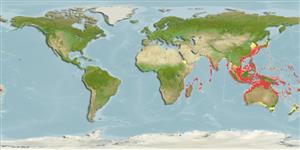Common names from other countries
>
Eupercaria/misc (Various families in series Eupercaria) >
Priacanthidae (Bigeyes or catalufas)
Etymology: Pristigenys: Greek, pristis = saw + Greek, genys, -yos = face (Ref. 45335).
More on author: Cuvier.
Environment: milieu / climate zone / пределы глубины / distribution range
экология
морской ассоциированный с рифами; пределы глубины 1 - 250 m (Ref. 100719), usually 5 - 30 m (Ref. 94109). Tropical
Western Pacific: Japan, East China Sea Shelf, Taiwan, South China Sea, Vietnam, Celebes, Australia, and Indonesia.
Size / Вес / Возраст
половая зрелость: Lm ? range ? - ? cm
Max length : 27.4 cm SL самец/пол неопределен; (Ref. 5403)
колючие лучи спинного плавника (общее число) : 10; членистые (мягкие) лучи спинного плавника (общее число) : 11; колючие лучи анального плавника: 3; членистые (мягкие) лучи анального плавника: 10; позвонки: 23. This species is distinguished from its congeners by the following set of characters: D X,11; A III,10; total gill rakers on first arch 27-31, mode 27 (upper limb 7-10, lower 19-22); lateral-line scales 31-39, mode 35; body scales above pectoral fin with about 11-60 spinules on posterior margin, the number increasing with growth; generally rounded caudal fin in young, becoming somewhat double emarginate in adults (noticeable in specimens over 15.0 cm SL); absence of black margins on posterior soft portions of vertical fins; 5 white or pale vertical bands (often indistinct) on body about 1/2-3/5 width of pupil expanded ventrally and dorsally with latter angled posterodorsally, very notable in young, less obvious in adults (Ref. 94109).
Body shape (shape guide): short and / or deep; Cross section: compressed.
Associated with rocky habitats and known from 80 to more than 100 m depth but probably also occurring in shallower water, especially as juveniles (Ref.5403). From dive observations, juveniles and young individuals likely occur at 5-30 m depths (Ref. 94109). Eggs are pelagic (0.75 mm), small and spherical.
Life cycle and mating behavior
половая зрелость | размножение | нерест | икра | Fecundity | личинки
Iwatsuki, Y., T. Matsuda, W.C. Starnes, T. Nakabo and T. Yoshino, 2012. A valid priacanthid species, Pristigenys refulgens (Valenciennes 1862), and a redescription of P. niphonia (Cuvier in Cuvier & Valenciennes 1829) in the Indo-West Pacific (Perciformes: Priacanthidae). Zootaxa 3206:41-57. (Ref. 94109)
Статус Красного Списка МСОП (Ref. 130435: Version 2025-1)
Угроза для людей
Harmless
Использование человеком
рыболовство: коммерческий
дополнительная информация
инструменты
Специальные отчеты
Скачать в формате XML
ресурсы в Интернет
Estimates based on models
Preferred temperature (ссылка
123201): 20.8 - 28.9, mean 27.6 °C (based on 972 cells).
Phylogenetic diversity index (ссылка
82804): PD
50 = 0.5312 [Uniqueness, from 0.5 = low to 2.0 = high].
Bayesian length-weight: a=0.02239 (0.00954 - 0.05253), b=2.93 (2.72 - 3.14), in cm total length, based on LWR estimates for this (Sub)family-body shape (Ref.
93245).
Trophic level (ссылка
69278): 3.9 ±0.5 se; based on size and trophs of closest relatives
устойчивость к внешним воздействиям (ссылка
120179): высокий, минимальное время удвоения популяции до 15 месяцев (Preliminary K or Fecundity.).
Fishing Vulnerability (Ref.
59153): Low vulnerability (23 of 100).
🛈
Nutrients (Ref.
124155): Calcium = 59 [29, 100] mg/100g; Iron = 0.642 [0.372, 1.050] mg/100g; Protein = 18.8 [17.6, 20.0] %; Omega3 = 0.143 [0.085, 0.240] g/100g; Selenium = 47.3 [25.9, 86.6] μg/100g; VitaminA = 48.2 [13.8, 166.8] μg/100g; Zinc = 0.988 [0.669, 1.420] mg/100g (wet weight);
